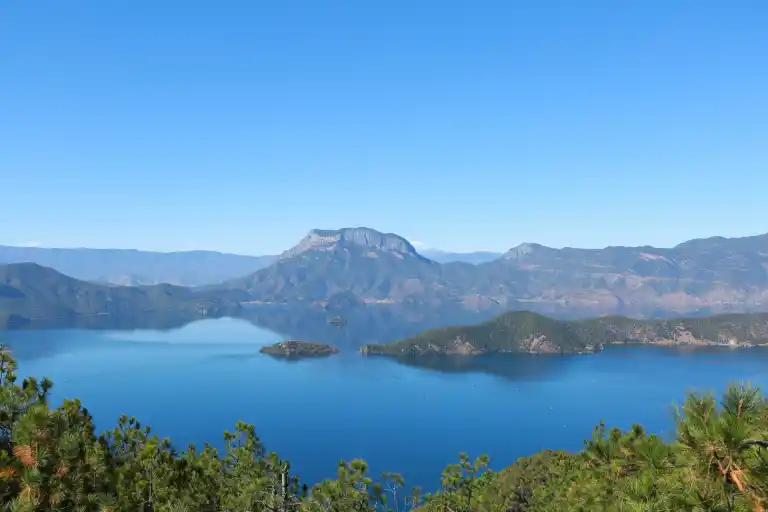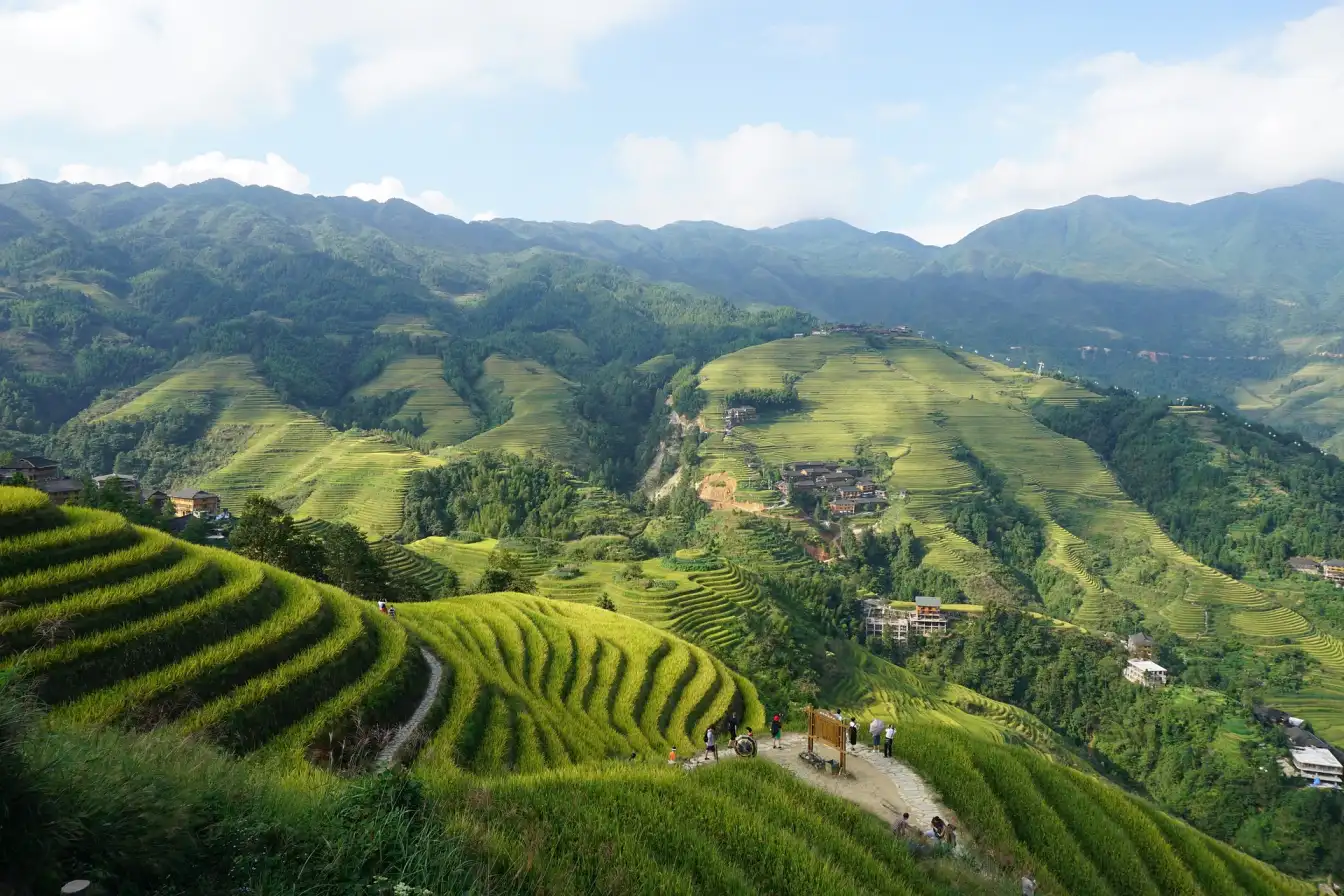
Dragon's Backbone Rice Terraces: Marvels of Chinese Landscape
1. Location and Overview 🏝️
Location: The Longji Rice Terraces (龙脊梯田) are located in Longsheng County (龙胜县), Guangxi Zhuang Autonomous Region (广西壮族自治区), China.
Overview: The Longji Rice Terraces, also known as the Dragon's Backbone Rice Terraces, are an impressive agricultural marvel that stretch across the mountainous terrain of Longsheng County. These terraces, carved by hand over centuries by the Zhuang and Yao ethnic minorities, create a breathtaking landscape of cascading steps filled with lush green rice paddies. The terraces are a testament to the ingenuity and hard work of the local farmers, and they offer a stunning and unique destination for travelers seeking natural beauty and cultural richness.
2. Unique Features 🏜️🌆
The Longji Rice Terraces are renowned for their stunning stepped landscape, which creates a mesmerizing visual effect as the light changes throughout the day. Key features include:
- Ingenious Engineering: The terraces are an impressive example of ancient engineering, utilizing the natural contours of the mountains to create efficient irrigation systems and arable land.
- Cultural Heritage: The terraces are closely tied to the culture and traditions of the Zhuang and Yao people, offering insights into their agricultural practices and way of life.
- Seasonal Beauty: The terraces change with the seasons, from lush green in summer to golden in autumn, and snow-covered in winter, making them a year-round attraction.
3. Seasonal Changes 🌷🌞🍁❄️
- Spring (March to May): The terraces begin to fill with water, creating beautiful reflections of the sky and surrounding mountains. This is the planting season, with vibrant green shoots starting to appear.
- Summer (June to August): The rice paddies are lush and green, and the fields are full of life. This is an ideal time for hiking and exploring the terraces.
- Autumn (September to November): The rice ripens and turns a golden yellow, creating a stunning contrast against the green hillsides. Harvest season offers a unique cultural experience.
- Winter (December to February): The terraces can be covered in snow, providing a serene and picturesque landscape. This is a quieter time to visit, with fewer tourists.
4. Best Time to Visit ⏰🌴
The best time to visit the Longji Rice Terraces is during the late spring (May) and autumn (September to October) months. During these periods, the weather is pleasant, and the terraces are at their most beautiful, either filled with water or glowing with ripe rice.
5. Travel Tips 🧳✈️
- Footwear: Wear comfortable hiking shoes with good grip, as the paths can be steep and slippery.
- Acclimatization: The terraces are located at high altitudes (up to 1,200 meters or 3,937 feet), so take it slow if you’re not used to the elevation.
- Cash: Carry sufficient cash (Chinese Yuan), as ATM machines are not widely available in the area.
- Guides: Consider hiring a local guide to gain deeper insights into the history and culture of the terraces.
- Weather: Bring layers and rain gear, as the weather can change quickly in the mountains.
- Respect Local Customs: Be respectful of the local communities, their land, and their customs.
6. Cultural Significance 🏯🌟
The Longji Rice Terraces hold great cultural significance for the Zhuang and Yao ethnic minorities. These terraces are not only a source of livelihood but also a representation of their deep connection to the land and their traditional agricultural practices. Festivals such as the Yao Red Clothes Festival celebrate their rich heritage, with traditional music, dance, and food.
7. Tourist Attractions 📸🏜️
- Ping’an Village (平安寨): Offers stunning views of the terraces and is a great starting point for hikes.
- Dazhai Village (大寨村): Known for its large and picturesque terraces, it provides a more secluded experience.
- Jinkeng Rice Terraces (金坑梯田): Famous for its beautiful sunrise and sunset views.
- Huangluo Yao Village (黄落瑶寨): A village known for the women who have the longest hair in the world.
- Seven Stars with Moon (七星伴月): A unique formation of seven small terraces around a larger one, resembling stars around the moon.
- Nine Dragons and Five Tigers (九龙五虎): A dramatic series of terraces that look like dragons and tigers from above.
- Ancient Zhuang Village (古壮寨): Provides insights into the traditional Zhuang way of life.
- Zhuang Ethnic Cultural Museum (壮族文化博物馆): Located nearby, it offers a deeper understanding of the local culture and history.
8. Nearby Attractions 🗺️
- Guilin (桂林): Famous for its karst mountains and the Li River, Guilin is a scenic city worth exploring.
- Yangshuo (阳朔): Known for its stunning countryside, rock climbing, and cycling routes.
- Reed Flute Cave (芦笛岩): A natural limestone cave with multicolored lighting showcasing impressive stalactites and stalagmites.
- Elephant Trunk Hill (象鼻山): A famous hill resembling an elephant drinking water.
- Yao Mountain (尧山): Offers panoramic views and a cable car ride to the summit.
- Fubo Hill (伏波山): Known for its stunning views and historical sites.
9. How to Get There ✈️🚤
- By Air: Fly to Guilin Liangjiang International Airport (桂林两江国际机场), then take a bus or taxi to Longsheng (about 2-3 hours).
- By Train: Take a train to Guilin Railway Station (桂林火车站) and then transfer to a bus or taxi to Longsheng.
- By Bus: Long-distance buses from Guilin Bus Station (桂林汽车站) to Longsheng Bus Station (龙胜汽车站) are available, followed by a local bus or taxi to the terraces.
10. Practical Information 💼💰
- Ticket Price: Entrance fee is around 100 RMB (approximately 16 USD) per person.
- Opening Hours: Open daily from early morning until late evening, but it’s best to visit during daylight hours for safety and better views.
- Facilities: Basic amenities like restrooms, food stalls, and souvenir shops are available in the main tourist areas.
11. Local Cuisine 🍲🥢
- Longji Bamboo Rice (龙脊竹筒饭): Rice and ingredients cooked in bamboo tubes, giving a unique flavor.
- Oil Tea (油茶): A traditional Yao tea made with tea leaves, oil, and various seasonings.
- Zhuang Chicken (壮家鸡): A local dish made with free-range chicken and regional spices.
- Sticky Rice Cakes (糍粑): Sweet or savory rice cakes popular among the Zhuang and Yao people.
- Wild Vegetable Stir-Fry (野菜炒): A healthy dish using locally foraged vegetables.
- Braised Pork with Preserved Vegetables (梅菜扣肉): A savory and sweet dish popular in the region.
12. Precautions to Take ⚠️
- Weather Conditions: Be prepared for sudden changes in weather; bring appropriate clothing and gear.
- Altitude: Take your time to acclimate to the high altitude to avoid altitude sickness.
- Safety: Stay on marked trails and paths to avoid accidents, as the terrain can be steep and slippery.
- Respect the Locals: Be mindful of local customs and practices, and avoid disturbing the local communities.
- Health: Carry basic medical supplies and any personal medication, as medical facilities may be limited.
13. Conclusion 🏝️
The Longji Rice Terraces offer a unique and captivating blend of natural beauty, cultural heritage, and outdoor adventure. Whether you’re exploring the intricate terraces, learning about the rich traditions of the Zhuang and Yao people, or simply taking in the stunning views, the Longji Rice Terraces promise an unforgettable journey into one of China’s most scenic and culturally rich landscapes. So pack your bags, lace up your hiking boots, and embark on an adventure to this enchanting corner of China! 🌄🌟














Comments
Leave a reply